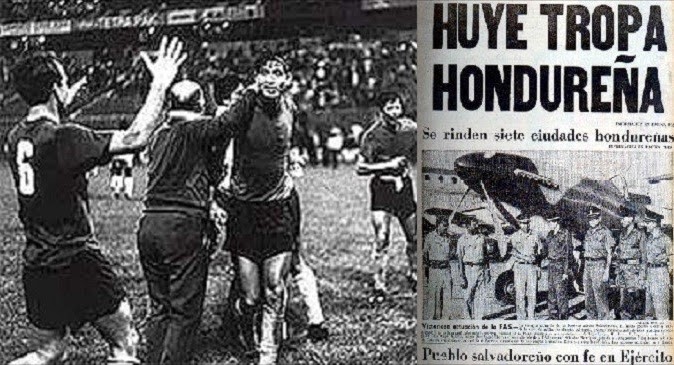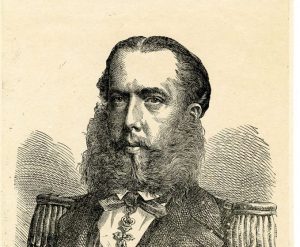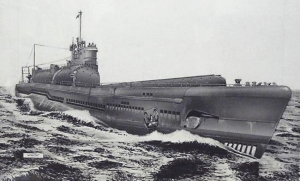
The 1969 play-off match between El Salvador and Honduras (two teams that are not only neighbors but rivals) was filled with anticipation and aggression. This playoff match would decide which nation would be attending the world cup, and which would be staying home. El Salvador and Honduras had each won one match which forced a third, and final, play-off match.1 In the prior matches, fights had broken out between fans in the street and in the stands during the game. But on the day of the final play-off, a much more significant event would take place. The game was scheduled in Mexico City: a third-party country with no bias toward either team. The day of the playoff, El Salvador dissolved all diplomatic ties with Honduras right before the match.
In the first game between the two nations, Honduras won the match 1-0 in its own capital. Some Hondurans stayed outside of the hotel that the El Salvador team had been staying at and threw rocks, set off car alarms and threw firecrackers.2 The 2nd match took place in San Salvador, where the home fans would watch their team win by a commanding score of 3-0. Before the 2nd match took place, the Honduran National team had a security force with them at all times. During the game the security at the stadium was extremely tight with lots of alcohol and weapons confiscated as a security precaution. As the Honduran national anthem played, the home team and fans were extremely disrespectful towards the players and their country. This caused some whiplash for El Salvadorians living in Honduras as their businesses were boycotted and vandalized.3 Leading up to the series of matches, the two nations were in a deep dispute over land reform and immigration. El Salvador was sending its poorest citizens into Honduras so the wealthy could maintain their land.4 El Salvador had a much bigger population than Honduras. Honduras had a population of about 2 million, where as El Salvador had a population of almost 4 million.5

However, they had a significantly smaller amount of land which forced more than 275,000 El Salvadorians to flee into Honduras, causing poverty and crime.6 Honduras accused the El Salvadorians of stealing jobs from the native people of Honduras. But after the 2nd games violence, El Salvador accused Honduras of staying silent while El Salvadorians living in Honduras were raped, murdered, robbed, and oppressed. Neither side was willing to negotiate to the smallest extent, which led to tensions building up even more. In the final match between the two teams, El Salvador won the game in overtime with the score of three to two.7 This caused numerous Salvadorians to be killed in Honduras.8
On July 14th, 1969, almost 3 weeks after the final playoff game, El Salvador bombed targets inside of Honduras. They crippled Honduras by attacking their main airport which left them unable to react to the attack at optimal speed.9 El Salvador then attacked from the ground by marching through the two main roads that connect the countries. Only one day later, the El Salvadorian army had pushed Honduras back over 8 kilometers. The El Salvadorian Army continued to make steady progress. They were nearing the capital city of Honduras, Tegucigalpa, when Honduras finally pushed back. The Honduran Air Force attacked Llopango base. The bombers eventually progressed to Acajutla port, which was important because it was home to El Salvadorian oil refineries. Later that evening huge smoke clouds covered the coast as the the oil refineries were bombed.10
Fearing that the nearing El Salvadorian army would overtake the capital, Honduras called the Organization of American States for help. The Organization of American States (OAS) had an urgent meeting on the evening of July 15th and called for El Salvador to withdraw its troops from Honduras ensuring that its people living in Honduras would not be harmed.11 El Salvador refused, demanding reparations be paid to them and their citizens. El Salvador attempted to further the attack the capital city, but they were unable to proceed with the attack. The previous strike on their oil refineries had destroyed their line of fuels and supplies and they no longer had supplies arriving every other day. Somoza Debayle, the dictator of Nicaragua was also helping Hondurans by arming them with weapons and providing ammunition. The OAS worked night and day in order to provide a cease-fire that would please both parties. Finally, on the night of July 18th, a ceasefire was arranged and became effective two days later.12
Although the cease-fire had been called, El Salvador refused to leave Honduras. They stayed until they were threatened by the OAS with economic sanctions against them. The El Salvador government finally withdrew troops on August 2, 1969. The aftermath of the 100-hour war was anything but slim. More than 2000 civilians were killed, with more than 100,000 immigrants displaced.13 Although they were no longer at war with each other, these two nations peace treaty only came into force on December 10, 1980.14
- Paul Joseph, The SAGE Encyclopedia of War: Social Science Perspectives, 2017 s.v . “Soccer War.” ↵
- Hatcher Graham, Salem Press Encyclopedia, 2013, s.v “Soccer War.” ↵
- Steve C. Ropp, 1982, “The War of the Dispossessed: Honduras and El Salvador, 1969. Thomas P. Anderson.” The Hispanic American Historical Review, no. 2: 296. JSTOR Journals, EBSCOhost (accessed February 5, 2018). ↵
- Richter, Ernesto, John Beverly, Bob Dash, and Irma Fernandez Dash. “Social Classes, Accumulation, and the Crisis of “Overpopulation” in El Salvador” Latin American Perspectives, 7, 1980 ↵
- Ernesto Richter, John Beverly, Bob Dash, and Irma Fernandez Dash. “Social Classes, Accumulation, and the Crisis of “Overpopulation” in El Salvador”, Latin American Perspectives, 7, 1980. ↵
- Charles Clements, Witness to War: an American Doctor in El Salvador (New York; Bantam Book, 1984). ↵
- Hatcher Graham, Salem Press Encyclopedia, 2013, s.v “Soccer War.” ↵
- Charles Clements, Witness to War: an American Doctor in El Salvador (New York; Bantam Book, 1984). ↵
- Charles Clements, Witness to War: an American Doctor in El Salvador (New York; Bantam Book, 1984). ↵
- Charles Clements, Witness to War: an American Doctor in El Salvador (New York; Bantam Book, 1984). ↵
- Charles Clements, Witness to War: an American Doctor in El Salvador (New York; Bantam Book, 1984). ↵
- Charles Clements, Witness to War: an American Doctor in El Salvador (New York; Bantam Book, 1984). ↵
- Charles, Clements, Witness to War: an American Doctor in El Salvador (New York; Bantam Book, 1984). ↵
- Charles Clements, Witness to War: an American Doctor in El Salvador (New York; Bantam Book, 1984); and United Nations -Treaties Series, General Peace Treaty Between the Republics of El Salvador and Honduras, 1980, https://peacemaker.un.org/sites/peacemaker.un.org/files/HN-SV_801030_GeneralTreatyOfPeaceElSalvadorHonduras.pdf. ↵



106 comments
Destiny Renteria
I love soccer, so this article is such a great read for me! I never thought there was such a great history behind it, especially for it to take a turn after one simple game. I appreciate the author writing about this article because not only is soccer the number one sport, but there is some controversial history to it. The author did a well job on telling this story and explaining how the treaty came about ELEVEN YEARS after this took place. Great job!
Marlene Lozano
I was surprised to read that a competitive soccer game quickly leads to a significant series of violence, including a bomb threat that was made. The author did a great job in the way they wrote this article, and it catches the readers attention. This article proves that soccer in Latin America is taken very seriously. Overall this was a great article!
Ximena Mondragon
Soccer is a very important sport in Latin America this why I think a soccer game got very violent and political. It is sad that over a soccer game people got violent and two neighboring nations had conflict. Overall, this article is well written and it gets to the point.
Maria Mancha
Soccer is such an amazing sport. For the peace treaty to come 11 years after all the fighting is just crazy. Ive always known soccer is a violent sport but I never thought it could go this far. I think the article was set up very well, it had a lot of details and at the same time was fun to read. Its shocking the way a simple game can come out to something so violent and controversial. The article was great and deserves its nomination. Great job Suvesh!
Miguel Camarillo-Cohen
Interesting article. While it is difficult to determine what really started the war between El Salvador and Honduras with the information provided; the articles suggest that a soccer match lead to war. Countries have gone to war for several reasons, from oil, to land to religion. However, it is hard to believe El Salvador and Honduras ended up in a war over soccer. The conflict lasted from 1969 to 1980 before both nations entered a piece accord. Hundreds died, and, hundreds more were left without homes. With two other nations meddling in the dispute between nations, the US and Nicaragua clearly did not help to bring peace.
Julio Morales
It amazes me how this all started because of a game of soccer. Thousands of people died over a silly rivalry. Even though this particular game happened a couple of decades ago; to this day that rivalry still exists. The only difference is that nowadays people do not go to the opposing teams hotel and throw rocks. I’m glad the OAS stepped in on time to reach an agreement to stop El Salvador from doing more damage to Honduras.
Samire Adam
I am shocked to find out that it took 10 years for both El Salvador and Honduras to format a peace treaty for a war that began over a football match. It makes sense now why football is the most popular sport in the world and football fans are the most passionate people. They are willing to go into war if their beloved team does not win.
Anthony Robledo
I love the name of the article. I enjoy soccer alot so it is great to see an article on it. You do a great job describing the tensions and emotions of the people. This reminds me of the same level of nationality that the olympics create. To think that a rivalry could go as far as bombing fans pf the opposing team is just crazy. Good job on the article and keep up the good work.
Gloria Baca
I loved how this article portrayed that a soccer game is not just a game, at least not for El Salvador and Honduras. This soccer game was not only a rivalry between teams but between nations also. The level of fierceness it reached was absolutely crazy. I enjoyed reading about a rivalry I had no knowledge. I enjoyed reading your article as it kept me intrigued throughout reading it. Great job!
Jonathan Perez
This article was well written and equally well researched. I commend the author’s knowledge of soccer and the history of the colliding nations. While I had known about a little bit of the rivalry between these two teams, I did not know about the blood shed that would come as a result of this match. Overall this article deserves the recognition it is receiving.